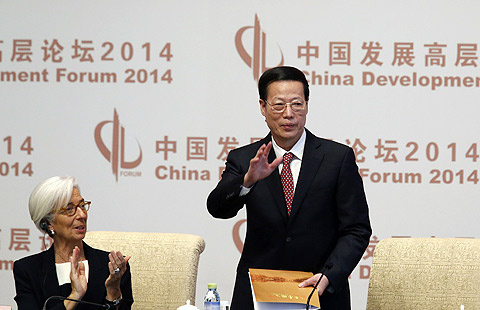Meeting the challenge to compete
Updated: 2014-03-28 08:41
By Huang Maoxin (China Daily Europe)
|
|||||||||||
Insufficient funding and lack of trained researchers are hindering domestic technological innovation
The 12th Five-Year Plan (2011-15) is of key importance to China's technological innovation and industrial upgrading. An innovation-driven strategy is essential for determining whether China can finish the planned task of industrial adjustment and reform.
But it is clear that the majority of provinces and regions still rely on investment and low labor costs to boost economic development, while only certain eastern provinces have realized the importance of an innovation-driven strategy and started shifting to the new mode. However, they face some common problems.
Compared with developed countries, China's technological resources are more dispersed, which has hindered them from playing an effective role in leading economic growth. Manufacturing industries are still at the low end of the international industrial chain, while only a very small percentage of enterprises own independent intellectual property rights to their products.
The problem is made worse by the widening gap between the eastern and western provinces and the lack of technological cooperation.
The lack of coordinated, more balanced development is still a bottleneck for China on its development path.
R&D spending generally accounts for more than 2 percent of GDP for most innovation-oriented countries. R&D investment of developed countries, such as the United States, Japan and those in the European Union, accounts for 86 percent of the world's total. China lags quite far behind - its investment in R&D, although it grew by 28.88 percent in 2011, was only 1.84 percent of its GDP, much lower than the 4.38 percent of Israel and the 3.09 percent of the US. Besides, while developed countries cover their R&D costs mainly through private financing, China follows the government-oriented model.
Insufficient funding also results in a lack of technological human resources. In 2011, there were only 16 researchers for every 10,000 laborers in China; the percentage was only 17.58 percent of that in the US in 2007 and 10.81 percent of that in Finland in 2011. The shortage of qualified workers is an increasingly common headache for enterprises, while leading experts are rare in China's research institutions.
China is famous for producing large quantities of technological essays every year, but these essays are hardly of any use. Being run like government agencies, China's universities and research institutions judge researchers' performance by the quantity of essays they publish, compelling them to produce essays as if on a production line. It is hard to imagine such academic rubbish will lead to technological innovations - surveys show that the contribution of technological advance to China's economic growth is 29 percent, while it is around 60 to 80 percent in developed countries.
No doubt China cannot challenge developed countries' monopoly on core technologies; data show that the US, the EU and Japan own 95 percent of all patents in biological engineering and medicine, while high-income countries get 98 percent of all the income from global technology transfer. China's degree of technological dependence is 50 percent while for the US and Japan it is 2 to 5 percent. China even has to import core parts for producing a cellphone or a TV set.
The value of China's high-tech industry reached $1.4 trillion in 2011, ranking first globally; but it had only 891 patents that year, or 1.36 percent of the world's total. That sums up China's position in technological innovation.
What are the root causes for this? There are several besides the above-mentioned insufficient funding and imbalances between eastern and western provinces. For example, China is restricted by its technology management system, which follows an outdated model that does not encourage its researchers to fulfill their potential.
Lack of IPR protection is another factor that curbs China's innovation efforts. In 2012, only 2,000 Chinese enterprises, or 0.03 percent of the total, owned independent intellectual property rights, while 99 percent of all enterprises have never successfully applied for a patent.
At the same time, China lags far behind in legislating for innovations; its current Scientific and Technological Progress Law, adopted in 1993, is inadequate, and its financing sector lacks coordination with innovation too.
It is all these factors together that restrict China's technological innovation. If China hopes to realize the goal of an innovation-driven strategy it must address these issues hindering its technological progress and introduce new mechanisms to better serve this end.
The author is a professor of economics at Fujian Normal University. The Chinese text of this piece appeared in Study Times. The views do not necessarily reflect those of China Daily.
(China Daily European Weekly 03/28/2014 page14)
Today's Top News
Partnership with Belgium, EU highlighted
Turkish PM wins local elections
Monday's search for MH 370 resumes: AMSA
Families of flight MH370 passengers 'need closure'
Greece passes new reform bill
Dobass demonstrators demand referendum
MH370 relatives demand answers
Turkey starts local elections
Hot Topics
Lunar probe , China growth forecasts, Emission rules get tougher, China seen through 'colored lens', International board,
Editor's Picks

|

|

|

|

|

|





